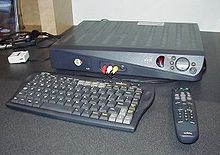WebTV Networks
The company WebTV Networks, Inc. offered the mid-1990s for a monthly fee of around 20 US dollars an unlimited access to the Internet .
The basic fee included five mailboxes for the family members' e-mail accounts. The prerequisite was on the one hand a special set-top box offered by Sony ( Sony INT-W100 Sony Internet Terminal ) and Philips ( Magnavox ), and on the other hand a conventional television set ; the Sony box cost just under $ 350, so the price was on the order of a cheap video recorder ; the monthly WebTV fees were also within the framework of the typical video rental budget.
By US standards, however , monthly ISP costs of almost $ 20 for Internet access via modem were very high, as flat rates were widespread there.
The company was taken over by Microsoft in 1997 . According to a report by the Bloomberg news agency , Microsoft anticipated a billion dollar loss between 1997 and 1999 as a result of its involvement in the Internet and intelligence services. This strategy fits in with Microsoft's commitment to multimedia reference works for the home sector (from 1994/1995), the development of its own online service Microsoft Network ( MSN , from 1995), the takeover of numerous photo agencies (from 1996 ; see Corbis ) as well as the cooperation with NBC and ZDF .
technology
The set-top box contained a V.34bis modem, a CPU and a sound card . WebTV was operated via a wireless remote control . A wireless keyboard was optionally available. The fees were billed via a smart card.
The set-top box had an integrated web browser that supported the common Internet standards such as HTTP , MIME and HTML . In addition to surfing the web, an email function was planned.
target group
WebTV aimed at the typical passive television viewer as its target group, who has neither computer knowledge nor technical understanding; WebTV was touted as a simple and "foolproof" all-in-one solution; from the advertisement for WebTV: "You're surfing the Web with a remote control in one hand and a handful of cheese puffs in the other. Now that's progress" . At the same time, however, it is also claimed: "WebTV. It isn't the idiot box anymore" .
Competitor
Samsung , Sony and Dual Technology presented comparable products at the end of the 1990s ; Like WebTV, the Dual Mediabox from Dual Technology is an additional TV device that connects the television to the ISDN telephone network. Together with Diba, Samsung developed a new line of internet-compatible televisions with built-in modems.
